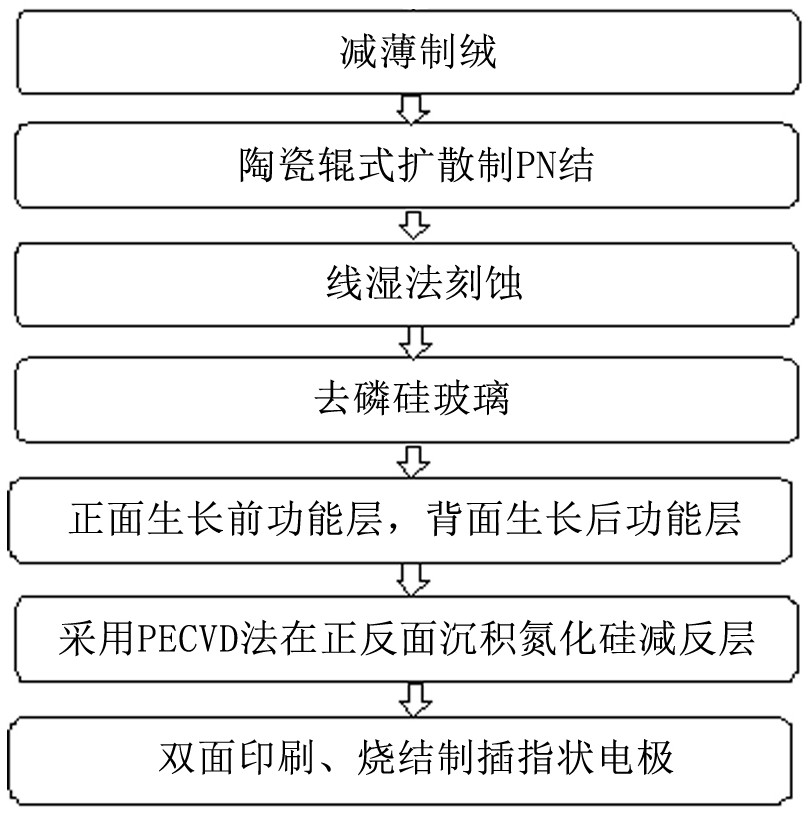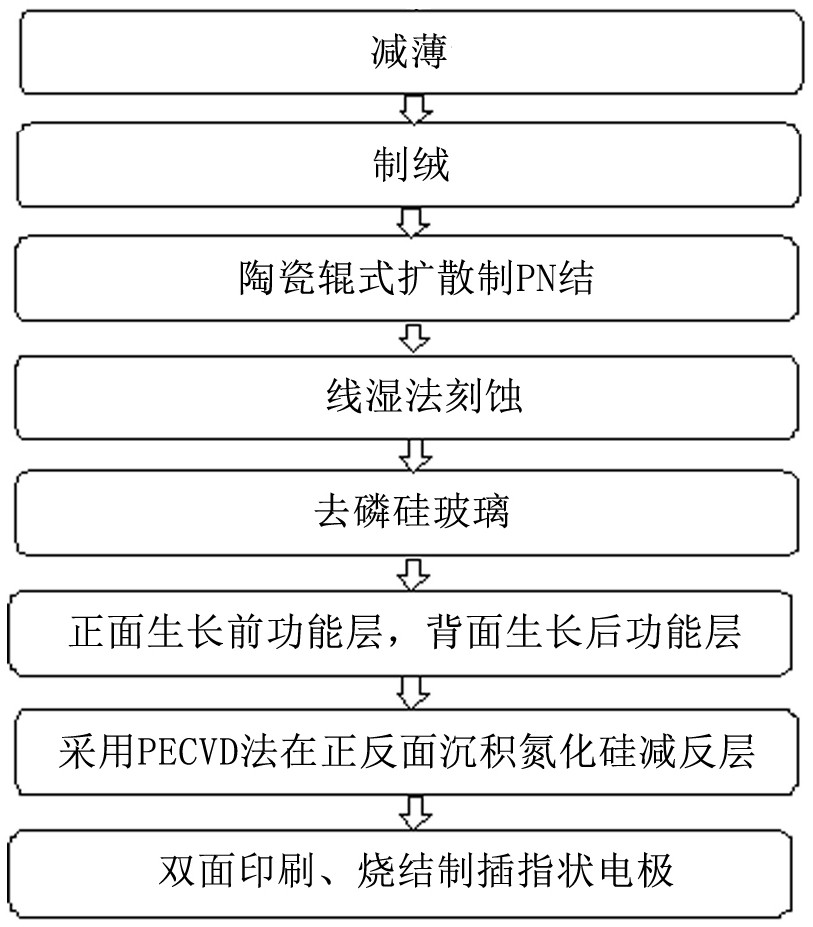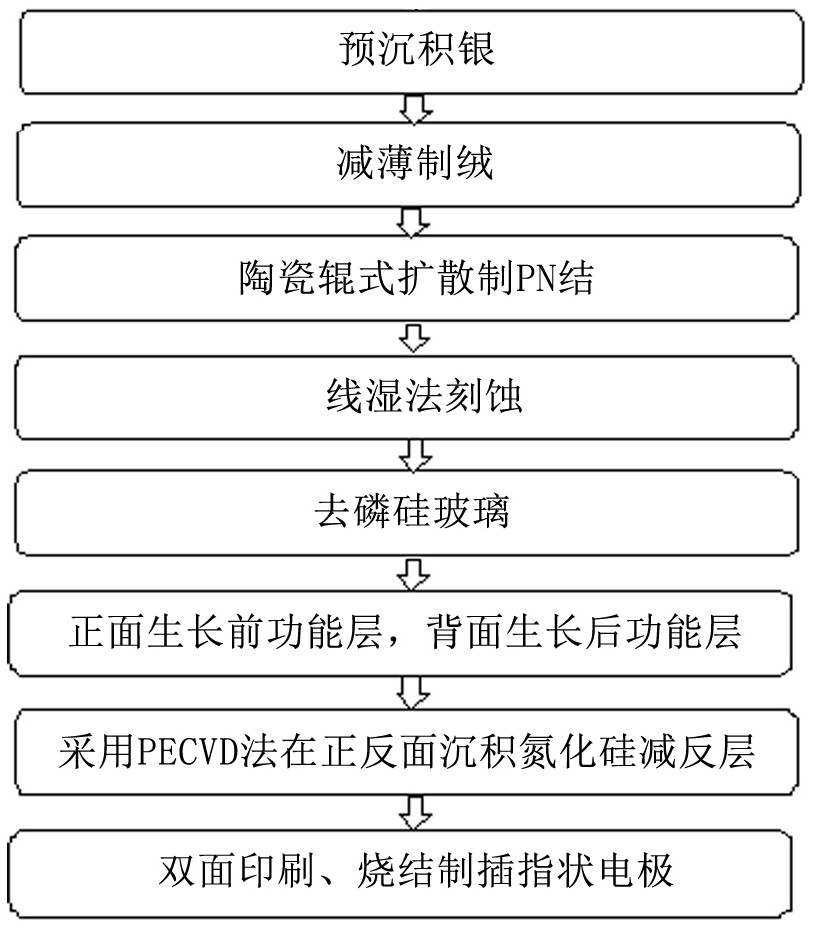A kind of preparation method of ultra-thin crystalline silicon double-sided solar cell
A solar cell and crystalline silicon technology, applied in the field of solar cells, can solve the problems of poor product diffusion junction uniformity, high breakage rate of thin silicon wafers, and difficulty in realizing industrialization, so as to increase the duration of light stay and improve the utilization rate of light energy. , the effect of reducing the breakage rate
- Summary
- Abstract
- Description
- Claims
- Application Information
AI Technical Summary
Problems solved by technology
Method used
Image
Examples
Embodiment 1
[0036] Such as figure 1 As shown, the preparation method of the ultra-thin crystalline silicon double-sided solar cell provided in this embodiment is as follows: Thinning texturing—ceramic roll diffusion to make PN junction—wire wet etching—phosphorous silicon glass removal—growth functional layer— Double-sided deposition of silicon nitride anti-reflection layer - screen printing, sintering finger electrode.
[0037] figure 1 Only the key steps in the present invention are shown, and some conventional processes such as cleaning are not listed here. The cleaning process includes cleaning before and after texturing. Before texturing, acetone and alcohol are generally used for ultrasonic cleaning to remove organic and inorganic impurities on the surface of the polysilicon substrate, and then cleaned with deionized water; after texturing, it is usually cleaned with Rinse with deionized water and blow dry with nitrogen. These conventional processes will not be described too much...
Embodiment 2
[0046] Thinning and texturing: place a 200μm thick P-type polysilicon substrate in HF, H 2 o 2 , silver nitrate and copper nitrate mixed solution, the mass fraction of HF is 35%, H 2 o 2 The mass fraction is 35%, the molar concentrations of silver nitrate and copper nitrate are 0.5mol / L and 0.3mol / L respectively, HF, H 2 o 2 The volume ratio of the additives (the additives here are silver nitrate and copper nitrate) is 3:2.5:1. Make the polysilicon substrate in HF, H 2 o 2 , silver nitrate and copper nitrate mixed solution at 25°C for 2200s, the polysilicon substrate is thinned to 100 μm, and the surface of the polysilicon substrate is made into a suede structure.
[0047] PN junction made by ceramic roller diffusion: prepare 4% phosphoric acid solution, and conduct ultrasonic atomization deposition on the thinned polysilicon substrate at 20°C (ultrasonic frequency is 1.8MHz, atomization rate is 2mL / min, and the median Diameter 4.0μm); then place the polysilicon substra...
Embodiment 3
[0054] Thinning and texturing: place a 220μm thick P-type polysilicon substrate in HF, H 2 o 2 and palladium nitrate mixed solution, the mass fraction of HF is 30%, H 2 o 2 The mass fraction is 38%, the molar concentration of palladium nitrate is 1.2mol / L, HF, H 2 o 2 The volume ratio of palladium nitrate and palladium nitrate is 4.5:2:1. Make the polysilicon substrate in HF, H 2 o 2 and palladium nitrate mixed solution at 23°C for 2000s, the thickness of the polysilicon substrate is reduced to 110 μm, and the surface of the polysilicon substrate is made into a textured structure.
[0055]PN junction made by ceramic roller diffusion: prepare 6% phosphoric acid solution, and conduct ultrasonic atomization deposition on the thinned polysilicon substrate at 22°C (ultrasonic frequency is 1.75MHz, atomization rate is 3mL / min, and the median Diameter 3.8μm); then place the polysilicon substrate on the ceramic roller, heat it to the temperature to be diffused by an infrared la...
PUM
| Property | Measurement | Unit |
|---|---|---|
| thickness | aaaaa | aaaaa |
| thickness | aaaaa | aaaaa |
| thickness | aaaaa | aaaaa |
Abstract
Description
Claims
Application Information
 Login to View More
Login to View More - R&D
- Intellectual Property
- Life Sciences
- Materials
- Tech Scout
- Unparalleled Data Quality
- Higher Quality Content
- 60% Fewer Hallucinations
Browse by: Latest US Patents, China's latest patents, Technical Efficacy Thesaurus, Application Domain, Technology Topic, Popular Technical Reports.
© 2025 PatSnap. All rights reserved.Legal|Privacy policy|Modern Slavery Act Transparency Statement|Sitemap|About US| Contact US: help@patsnap.com



